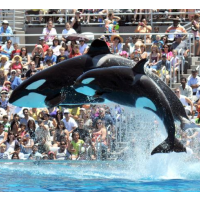Coastal Commission Bans Whale Sex at San Diego SeaWorld
 (photo: SeaWorld San Diego)
(photo: SeaWorld San Diego)
The 11 killer whales at SeaWorld San Diego can have a new, expanded $100-million habitat, but won’t be able to breed anymore.
Those were the terms laid down by the California Coastal Commission last week when it voted to allow the expansion over the protests of animal rights activists who would rather the orcas be freed. The commission, which can assign conditions in any construction projects within 1,000 feet of the ocean, restricted how whales can be brought to the park and banned their breeding in captivity there.
Park officials were not happy. “Depriving these social animals of the natural and fundamental right to reproduce is inhumane and we do not support this condition,” parent company President and Chief Executive Officer Joel Manby said in a statement. The ban includes artificial insemination.
SeaWorld San Diego President John Reilly told the Los Angeles Times, “A ban on breeding would sentence these animals to a slow extinction in our care.” Company officials said they were considering their options. The Associated Press said SeaWorld attorney David Watson told the commission, “The state of California does not have jurisdiction to regulate the management and care of marine mammal collections.”
Activists applauded the decision, noting it’s not very humane to keep, in tanks, giant, intelligent creatures that traverse the oceans when free, no matter how luxurious their accommodations.
The whales were certain to be unhappy no matter which way the commission voted.
The decision would not impact federal permits that let SeaWorld take a limited number of whales from the ocean, but some observers thought the amended prohibition would kill the park. The whales are its biggest attraction.
SeaWorld wants to double the space for the orcas in its Blue World Project. The four-story-high viewing gallery showcases a tank 50-feet high with a surface area of 1.5 acres. It has a “ ‘fast water current’ that allows whales to swim across moving water.”
The SeaWorld promotion for the project describes how “guests can walk alongside our killer whales as if at the shore, interact with them at depths found in the ocean, or see them from a bird’s eye view.”
SeaWorld has been under increased pressure since the 2013 release of the documentary “Blackfish,” built around the Orlando SeaWorld orca Tilikum that killed three people (two trainers and a trespasser) and the conditions of captivity that may have contributed to its behavior. The company’s stock has been battered, activists have been more active and lawmakers have weighed in.
State legislation was introduced last year to make “it unlawful to hold in captivity, or use, a wild-caught or captive-bred orca, as defined, for performance or entertainment purposes.” It died in committee and was not reintroduced this year.
–Ken Broder
To Learn More:
Orca Dispute Between Seaworld, Coastal Commission Could Go to Court (by Tony Perry, Los Angeles Times)
California Approves SeaWorld’s Whale Habitat Expansion but Bans Breeding (by Christine Hauser, New York Times)
Here's Why Sea World in San Diego Can't Breed Killer Whales Any Longer (by Kevin Drum, Mother Jones)
San Diego: Facing Ban on Orca Breeding, Seaworld Contemplates Next Move (by Julie Watson, Associated Press)
Coastal Commission Bans Captive Orca Breeding at SeaWorld San Diego (by Hugo Martin, Los Angeles Times)
SeaWorld Orca Show Goes on as Ban Dies in Legislature (by Ken Broder, AllGov California)
- Top Stories
- Controversies
- Where is the Money Going?
- California and the Nation
- Appointments and Resignations
- Unusual News
- Latest News
- California Forbids U.S. Immigration Agents from Pretending to be Police
- California Lawmakers Urged to Strip “Self-Dealing” Tax Board of Its Duties
- Big Oil’s Grip on California
- Santa Cruz Police See Homeland Security Betrayal in Use of Gang Roundup as Cover for Immigration Raid
- Oil Companies Face Deadline to Stop Polluting California Groundwater





